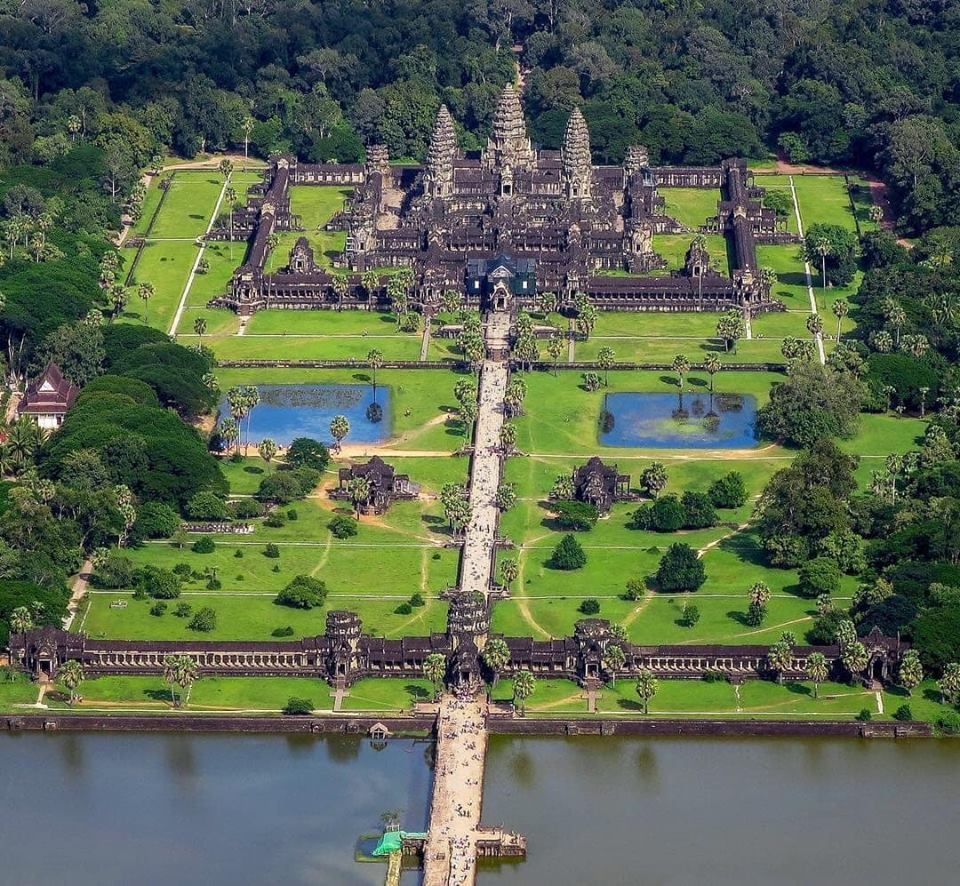
Introduction
Nestled near the city of Siem Reap in Cambodia, Angkor Wat is a stunning testament to the ingenuity and spiritual devotion of the Khmer Empire. Built in the early 12th century by King Suryavarman II, it remains the largest religious monument in the world, drawing millions of visitors annually. Beyond its scale and grandeur, Angkor Wat is a masterpiece of architectural symbolism, reflecting deep religious meanings, cosmic order, and political power.
This article delves into the architectural symbolism of Angkor Wat and its historical significance, exploring how this ancient temple embodies the cultural and spiritual heart of Cambodia.
Historical Background of Angkor Wat
Bird’s-eye view of the Angkor Wat temple complex showcasing its vast layout.
Constructed between 1113 and 1150 AD under the reign of King Suryavarman II, Angkor Wat was originally dedicated to the Hindu god Vishnu, unlike many other Khmer temples that honored Shiva or Buddhist deities. The temple served both as a political statement and a place of worship.
Over centuries, Angkor Wat evolved into a Buddhist site, reflecting Cambodia’s religious shifts. Its preservation as a UNESCO World Heritage Site underscores its global cultural importance and makes it a symbol of national pride for Cambodians.
Architectural Symbolism: Reflecting the Cosmos and Spiritual Beliefs
The Cosmic Mountain: Mount Meru Representation
At the heart of Angkor Wat’s design lies the concept of Mount Meru, a sacred mountain in Hindu, Buddhist, and Jain cosmology considered the center of the universe.
-
The central tower of Angkor Wat represents the summit of Mount Meru.
-
Four smaller towers surround the main tower, forming a quincunx pattern symbolizing the five peaks of the cosmic mountain.
-
The temple is enclosed by walls and a wide moat, representing the cosmic ocean surrounding Mount Meru.
This symbolic layout reflects the Khmer Empire’s desire to embed cosmic order and divine authority into the architecture, reinforcing the king’s status as a divine ruler.
Orientation and Astronomical Alignments
Unlike many temples oriented eastward, Angkor Wat faces west, traditionally associated with death and Vishnu, the presiding deity of the temple. Scholars suggest this westward orientation may signify the temple’s funerary purpose, marking it as a tomb for King Suryavarman II.
The temple’s layout also aligns with celestial events. The equinox sunrise aligns perfectly with certain temple corridors, while shadows during solstices create intricate patterns, showcasing the Khmer’s advanced astronomical knowledge.
Artistic Mastery: Bas-Reliefs and Carvings
Detailed carving of an apsara (celestial dancer) symbolizing divine beauty and grace.
Angkor Wat’s walls are adorned with some of the most exquisite bas-reliefs ever created:
-
Epic Narratives: Stories from the Hindu epics Ramayana and Mahabharata are carved in elaborate detail, illustrating mythical battles, gods, and cosmic events like the “Churning of the Ocean of Milk,” a symbol of eternal struggle and renewal.
-
Apsaras and Devatas: Sculpted celestial dancers and guardian deities symbolize divine presence and protection. These figures exhibit remarkable craftsmanship and grace, reflecting Khmer artistic sophistication.
-
Daily Life Scenes: Some carvings depict everyday Khmer life, offering insights into ancient customs and society.
These artworks not only decorate but convey spiritual teachings and cosmological principles, turning the temple into a visual scripture.
Construction Techniques and Materials
Building Angkor Wat required remarkable engineering prowess:
-
Materials: Primarily built from sandstone quarried about 50 kilometers away, transported via a complex network of canals and rivers.
-
Laterite Foundation: The temple’s base uses laterite, a durable soil material ideal for foundation work.
-
Precision: The temple’s stones fit together with incredible precision, often without mortar, highlighting advanced masonry skills.
The construction reflects an enormous mobilization of labor, resources, and knowledge, indicative of the empire’s wealth and organizational capacity.
Cultural and Religious Evolution
Originally a Hindu temple dedicated to Vishnu, Angkor Wat gradually became a center for Theravada Buddhism:
-
Buddhist statues and inscriptions were added over time.
-
The temple remains an active religious site, visited by monks and pilgrims.
-
This religious transition illustrates Cambodia’s dynamic spiritual landscape.
Preservation Challenges and Tourism
Tourists visiting Angkor Wat, highlighting its global appeal.
Today, Angkor Wat faces several preservation challenges:
-
Environmental factors such as tropical weather, vegetation overgrowth, and water damage.
-
Wear and tear from millions of tourists.
-
Efforts by UNESCO and Cambodian authorities focus on balancing conservation with public access.
Responsible tourism helps sustain this heritage site for future generations while boosting Cambodia’s economy.
Why Visit Angkor Wat?
Visiting Angkor Wat offers more than sightseeing:
-
Experience the majestic sunrise reflecting over the temple pond—a photographer’s dream.
-
Explore the vast galleries and intricate carvings that tell ancient tales.
-
Witness a living monument that connects the present with a magnificent past.
-
Understand the symbolism embedded in its architecture, enriching your appreciation of Khmer culture.
Conclusion
Angkor Wat is not just the world’s largest religious monument; it is a timeless symbol of spiritual devotion, royal power, and architectural genius. Its design encapsulates cosmic order, religious symbolism, and cultural identity, offering profound insights into the Khmer Empire and Southeast Asia’s history.
For historians, architects, travelers, and spiritual seekers, Angkor Wat stands as a magnificent reminder of human creativity and devotion.
SEO Keywords:
Angkor Wat, Angkor Wat Cambodia, Khmer Empire, Angkor Wat architecture, Mount Meru symbolism, Angkor Wat history, Angkor Wat bas-reliefs, UNESCO World Heritage Site Cambodia, Angkor Wat tourism, Cambodian temples.

You must be logged in to post a comment.